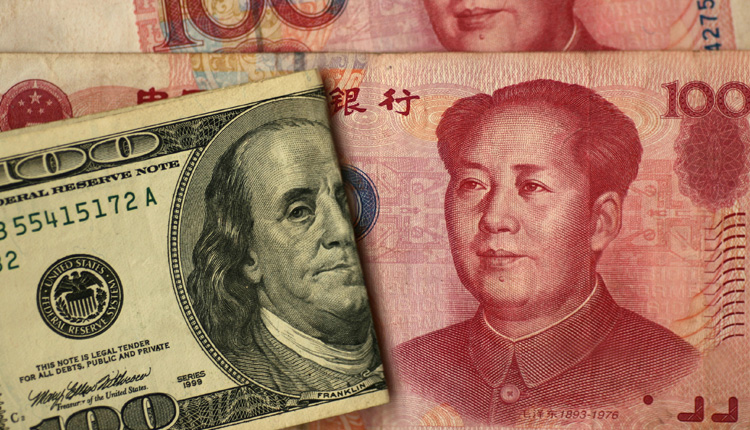China’s currency on Tuesday hit its lowest level against the greenback in 11 months amid concerns that a tariff conflict between Beijing and Washington could spiral into a full-blown trade war.
Both the onshore and offshore yuan crossed the 6.7 per dollar level for the first time since August 2017 during Tuesday’s Asian trading session. The onshore yuan traded at 6.6748 to the dollar at 3:10 p.m. HK/SIN, regaining some ground after earlier weakening to 6.7168. In the offshore market, where the yuan is less tightly controlled, the currency traded at 6.6911.
The People’s Bank of China had set the yuan mid-point at 6.6497 to the dollar before Tuesday’s market open — its weakest fixing since August 2017 and around 0.5 percent weaker than Monday’s 6.6157 mid-point. The central bank usually allows the yuan to rise or fall in a 2 percent band against the dollar, relative to the midpoint.
The moves come as the world’s two largest economies prepare to enforce retaliatory trade tariffs. President Donald Trump’s administration is set to slap a 25 percent duty on $34 billion worth of Chinese products, which spans more than 800 product categories, on July 6. Chinese President Xi Jinping’s government will also impose a 25 percent tax on U.S. goods worth the same amount that same day.
That’s hurt sentiment in Chinese markets as investors drop emerging market currencies for the safe-haven dollar.
PBOC Governor Yi Gang on Tuesday attributed the sharp moves in the yuan to strength in the dollar, as well as external uncertainties, Reuters reported.
The yuan has built up losses of 3.25 percent in June, drawing comparisons to August 2015 when the central bank unexpectedly allowed the currency to weaken nearly 3 percent against the U.S. dollar — a move that triggered heavy capital outflows.
Still, many don’t foresee a repeat of 2015.
“11 August 2015 was a crisis caused by the central bank,” Iris Pang, greater China economist at ING, said in a note. “Today’s depreciation is market-driven, reflecting the risks of a trade war. This implies that the central bank is allowing market forces to dictate the speed of the depreciation when there is room to do so.”
China’s currency hit its lowest level against the greenback in 11 months on Tuesday amid concerns that a tariff spat between Beijing and Washington could spiral into a full-blown trade war.
Both the onshore and offshore yuan crossed the 6.7 per dollar level for the first time since August 2017 during Tuesday’s Asian trading session. The onshore yuan traded at 6.6748 to the dollar at 3:10 p.m. HK/SIN, regaining some ground after earlier weakening to 6.7168. In the offshore market, where the yuan is less tightly controlled, the currency traded at 6.6911.
The People’s Bank of China had set the yuan mid-point at 6.6497 to the dollar before Tuesday’s market open — its weakest fixing since August 2017 and around 0.5 percent weaker than Monday’s 6.6157 mid-point. The central bank usually allows the yuan to rise or fall in a 2 percent band against the dollar, relative to the midpoint.
The moves come as the world’s two largest economies prepare to enforce retaliatory trade tariffs. President Donald Trump’s administration is set to slap a 25 percent duty on $34 billion worth of Chinese products, which spans more than 800 product categories, on July 6. Chinese President Xi Jinping’s government will also impose a 25 percent tax on U.S. goods worth the same amount that same day.
That’s hurt sentiment in Chinese markets as investors drop emerging market currencies for the safe-haven dollar.
PBOC Governor Yi Gang on Tuesday attributed the sharp moves in the yuan to strength in the dollar, as well as external uncertainties, Reuters reported.
The yuan has built up losses of 3.25 percent in June, drawing comparisons to August 2015 when the central bank unexpectedly allowed the currency to weaken nearly 3 percent against the U.S. dollar — a move that triggered heavy capital outflows.
Still, many don’t foresee a repeat of 2015.
“11 August 2015 was a crisis caused by the central bank,” Iris Pang, greater China economist at ING, said in a note. “Today’s depreciation is market-driven, reflecting the risks of a trade war. This implies that the central bank is allowing market forces to dictate the speed of the depreciation when there is room to do so.”
ING has revised its yuan forecast from 6.6 per dollar to 7 by the end of the year.
And unlike 2015, there aren’t major concerns of a hard landing for China’s economy at this time, according to Claudio Piron, co-head of Asia rates and FX strategy at Bank of America Merrill Lynch Global Research.
Pan Gongsheng, the head of China’s foreign exchange regulator, expressed confidence in the government’s ability to maintain the yuan at a “reasonable” level, Reuters reported on Tuesday. PBOC head Yi reiterated those comments, adding that China would proceed with prudent monetary policy, the news agency also said.
Source: CNBC



